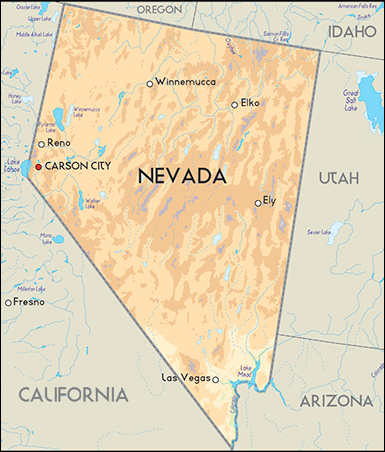By Jim Ellis
 May 8, 2020 — The Silver State of Nevada, with six Electoral College votes, has been regarded as a swing state in most 21st Century presidential elections, but in projecting the 2020 vote, it is routinely considered as a place destined to land in the Democratic column. But, could Nevada ultimately be in play for President Trump?
May 8, 2020 — The Silver State of Nevada, with six Electoral College votes, has been regarded as a swing state in most 21st Century presidential elections, but in projecting the 2020 vote, it is routinely considered as a place destined to land in the Democratic column. But, could Nevada ultimately be in play for President Trump?
With a general election electoral vote map looking ever closer as we move toward November, introducing a new target could drastically change the eventual outcome or at least the campaign focus and strategy.
A new ALG Research poll (April 27-30; 76 likely Nevada general election voters) reports findings that are consistent with virtually all of the 2016 Nevada general election surveys. Last week, the firm found former vice president Joe Biden leading President Trump with a 49-45 percent spread. Such a margin and preference percentages fall into the same realm as all 31 polls conducted in Nevada from May through the November 2016 election.
When ‘16 ended, Hillary Clinton carried the state, but her margin was only 2.4 percentage points, meaning a 27,000-vote spread of more than 1.12 million ballots cast. And, consistent with the large number of polls that concluded a close race within the 40s would be the actual result, Clinton defeated Trump, 47.9 – 45.4 percent, validating the plethora of research conducted over the final five-plus months of that election cycle.
Four years ago, 13 different pollsters conducted the almost three dozen surveys, and in no instance did either Trump or Clinton ever reach the 50 percent plateau. On the other end of the spectrum, in just three instances did one of the candidates dip below 40 percent. Therefore, in 28 of the 31 studies logged within the 2016 Real Clear Politics polling archives, both candidates fell within the 40s, meaning this result occurred over 90 percent of the time. In terms of range, the span stretched from Clinton plus-7 to Trump plus-6, but the average between the two was only 2.7 percent, which is almost exactly the actual final total. This obviously suggests a competitive political battlefield.
Such a pattern again appears to be emerging in 2020, but the more recent vote totals at first glance seem to tell a different story. In three polls conducted this year, including ALG’s just-released study, both Biden and Trump mainly fall within the 40s, except for an early January Fox News poll that found the president recording only 39 percent support.
Turning to vote history, the 2016 and ’18 statewide race results yield seven Democratic victories in eight statewide contests, suggesting that Nevada has definitively moved into that party’s column. Yet, in only three of the victories did the winner reach the 50 percent mark, and in no case did a victorious candidate touch 51 percent. In another three of the races, the margin spread was less than one percentage point. Therefore, despite the lopsided number of victories going to candidates from just one political party, the totality of the vote history still suggests that Nevada is highly competitive.
Strategically, the Trump campaign is first concentrating on winning the president’s five key core states of Arizona, Texas, Georgia, Florida, and North Carolina, and then moving onto taking at least one of the swing Great Lakes states meaning Pennsylvania, Michigan, or Wisconsin. If Biden were to win any one of the Trump core five, he would likely win the national election.
Therefore, the Trump campaign’s attempt to expand the battleground and pull another state from the group of states that Clinton won in 2016 would go a long way toward relieving pressure from the top-tier states, putting the Biden campaign on defense, and making the victory path considerably easier for the president.
This would again make Nevada a prospect for further political action and competition. We can expect the Trump campaign to also venture into Minnesota and New Hampshire, two other close 2016 Blue states that the Trump brain trust believes could potentially wind up flipping to Red.
The Biden campaign can also expect to attack in what were 2016 Red states. Among their potential prospect targets are Ohio, formerly a swing state, and possibly Alaska, and the 2nd Congressional District of Nebraska. To refresh, Nebraska and Maine split their electoral votes meaning single votes can be won by taking specific congressional districts within those states even though the opponent prevails in the statewide total.
In conclusion, while the 2020 battleground map appears to be confined to eight states and two districts, it is conceivable that we will see an expansion into additional territory before the campaign reaches political prime time.
